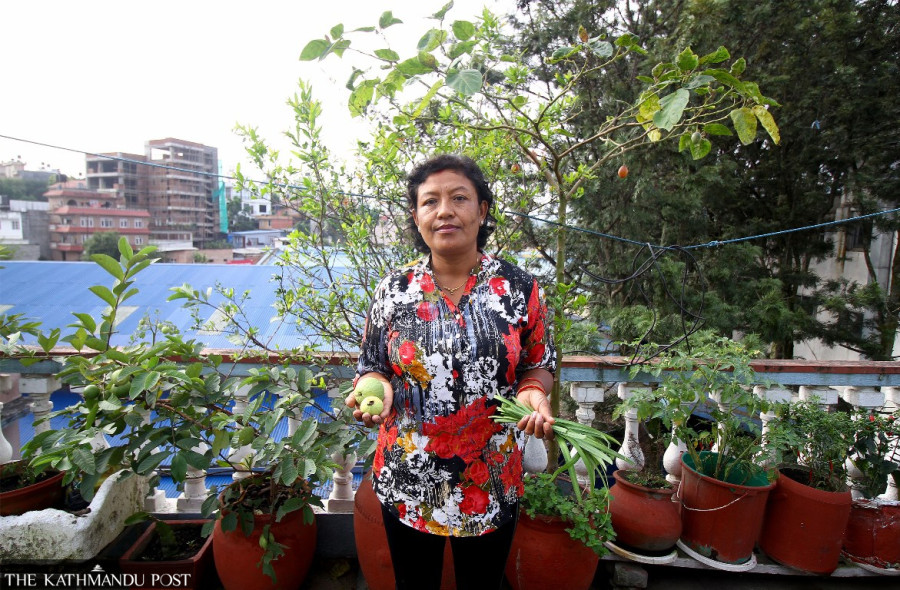Culture & Lifestyle
Rooftop farming is here to stay
Ever-increasing land prices and dubious quality of vegetables have made many in the Valley convert their rooftops to urban farms.
Pinki Sris Rana
Every morning, Asta Maya Dangol heads to her rooftop to pick vegetables and herbs to cook for the day. A resident of Dhobighat, Dangol has filled her rooftop with herbs and vegetables growing in clay pots, plastic crates, sacks, and white styrofoam boxes.
There are guava and dragon fruit trees. A few boxes have ripe cauliflower ready for harvest. There are tomatoes (in varying stages of ripening), Chinese leek, and vines of common beans and yardlong beans supported by thin metal poles.
Dangol checks her plants and trees, and before leaving the rooftop, she plucks a few tomatoes, guavas, and Chinese leek for the meal.
“I wanted to start rooftop farming many years ago, but it was only during last year’s lockdown that I finally got around to actually doing it. I think deciding to start rooftop farming was one of the best decisions I have made during the lockdown,” says Asta Maya Dangol.
Ever-increasing land prices and dubious quality of vegetables have made many in the Valley convert their rooftops to urban farms. However, it was only in 2013 that the concept of rooftop farming (kausi kheti) started becoming really popular. That year, Kathmandu Metropolitan City (KMC), in association with RUAF (Resources Centres on Urban Agriculture and Food Security) Foundation; UN-Habitat; and Environment and Public Health Organization (ENPHO), gave rooftop farming training to 150 households within the Valley. This training was an integrated course of solid waste management, wastewater management, and rooftop vegetable gardening.
Sanumaya Maharjan was KMC’s focal person for the 2013 rooftop farming training programme. During the programme, Maharjan spent many days giving training and orientations to families.
“In 2013, we focused on utilising biodegradable solid waste and wastewater that came from the kitchen. We encouraged people to use peels of onion, potato, and banana to make organic compost for rooftop vegetable farming and water the plants with water used to wash rice or dal,” says Maharjan. “Much to our surprise, during the lockdown, we saw an increased interest from people in starting rooftop farming. During last year’s lockdown, I was busy giving webinar sessions on rooftop farming.”
For many years, fifty-year-old Binoj Raj Shakya grew flowers on his rooftop, but it is only very recently that he started growing vegetables and herbs.
“I grow organic cauliflowers, taro leaves, and tomatoes on my rooftop,” says Shakya.
Like many, Shakya started rooftop farming primarily because of the ever-increasing prices of vegetables in the Valley and the overuse of pesticides in vegetables, which gets published in the news now and then. The last year's lockdown gave him the time required to tend to the plants.
“Since it's impossible to grow all the vegetables we consume on my rooftop, I have to buy some vegetables from the market. But growing some of my own vegetables has lessened my dependence on market's vegetables, and it has allowed me to save some money as well,” says Shakya.
While the vast majority of households that do rooftop farming do so for their own consumption, there are a few outliers who have commercialised their rooftop farming.
Brothers Microgreens is one such rooftop farming enterprise. Started by Prashant Raj Giri and Niroj Khadka in 2019, the business produces and sells microgreens, young vegetable greens used for salads and garnishes.
“When rooftop farming started becoming popular in the Valley, we realised that we could use our own rooftops to grow vegetables for commercial consumption as well,” says 24-year-old Giri, who is an agriculture student. “After conducting a lot of research, we decided to commercially grow microgreens on our rooftops using our expertise and knowledge. We started this business with an investment of Rs200,000, and in the last two and half years, we have sold around Rs1.2 million worth of produce to some of the leading five-star hotels in the Valley.”
As more and more people start rooftop farming, Maharjan says it’s important to know certain fundamental things before they start.
“Since last year’s lockdown, the Valley has seen a huge surge in the number of households starting rooftop farming. But many have gotten into it without having the proper knowledge. Many households have filled their rooftops with so many plants that the weight could compromise the buildings’ structure,” says Maharjan. “A roof of a regular house made on four annas of land has a maximum load-bearing capacity of 3,000 kgs. Since most households in the Valley have two 1,000 litre water tanks on their roofs, we advise families not to exceed 1,000 kgs for their pots, plants, and soil for rooftop farming. The plants must also be placed on the opposite side of the water tanks so that the weight is spread evenly across the roof.”
According to Shakya, another important thing the families need to understand while rooftop farming revolves around the usage of fertilisers and pesticides.
“Fertilisers play an important role in ensuring healthy plants and pesticides to keep away harmful pests. But instead of using chemical fertilisers and pesticides, I suggest people explore organic materials,” says Shakya. “Mixtures of burnt ashes, sand, and other biodegradable kitchen waste can be used as an alternative to fertilisers.”
Ever since Dangol started rooftop farming, she has been spending considerable time on YouTube researching ways to make fertilisers and pesticides at home.
“Pests damaging plants is one of the major concerns for rooftop farmers like me. Most people give up on farming altogether because pests destroy their plants, and they can’t eradicate them properly. Some resort to using harmful pesticides,” says Shakya. “I have been researching a lot on YouTube on ways to make organic pesticides and fertilisers. I learned from YouTube that chilly powder mixed in water repels pests. There are so many such tips on YouTube one can use.”
Apart from providing her family with a steady supply of herbs and vegetables, Dangol says farming has also been therapeutic.
“We live in a concrete jungle, so it’s nice to have my own few square metres of greenery on my roof,” says Dangol. “For me, rooftop farming has served multiple purposes, and I am glad I started it last year. I think more people should do it and get into it and make the most of their empty and underused roofs.”




 5.4°C Kathmandu
5.4°C Kathmandu













%20(1).jpg&w=300&height=200)

